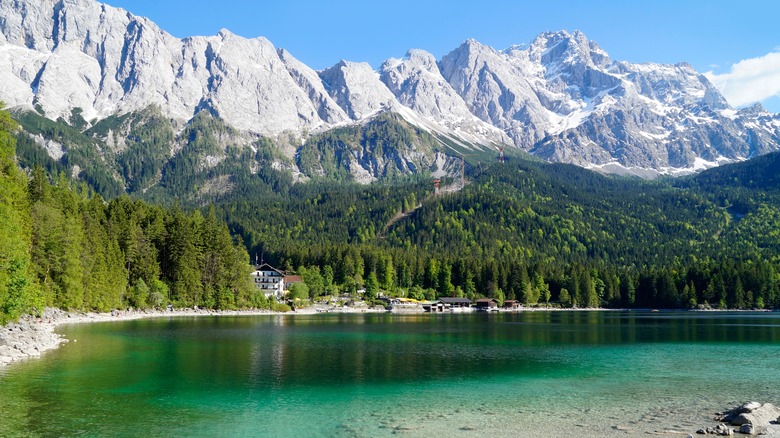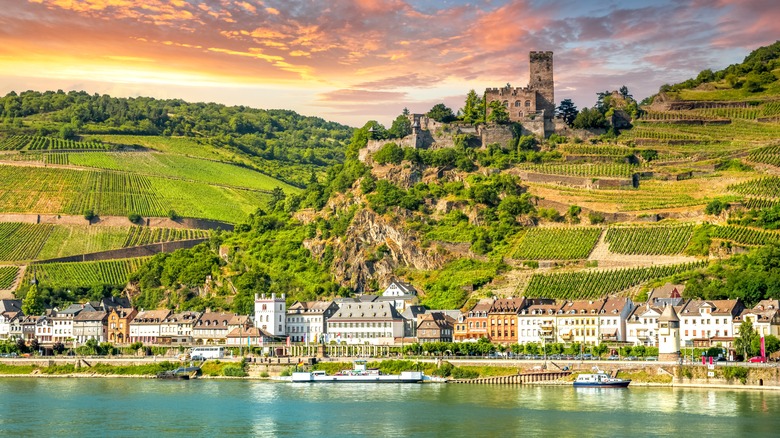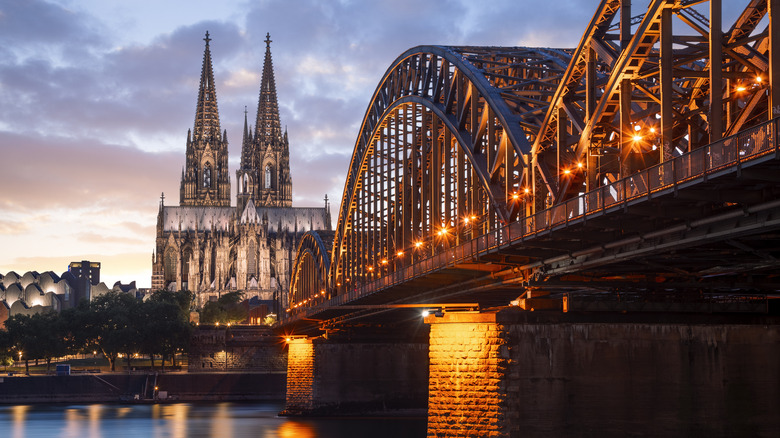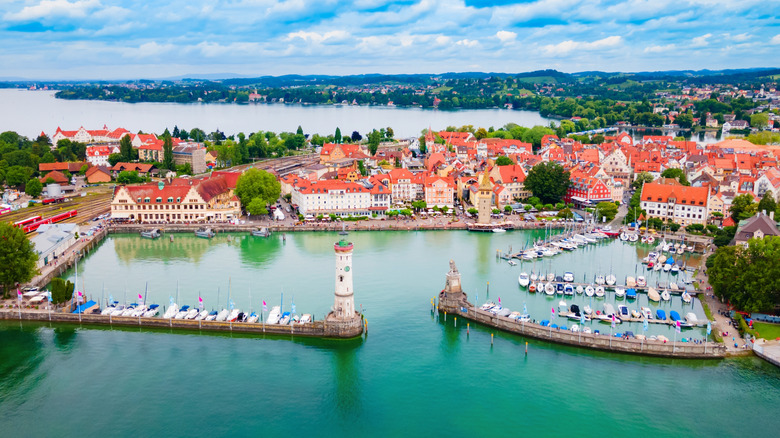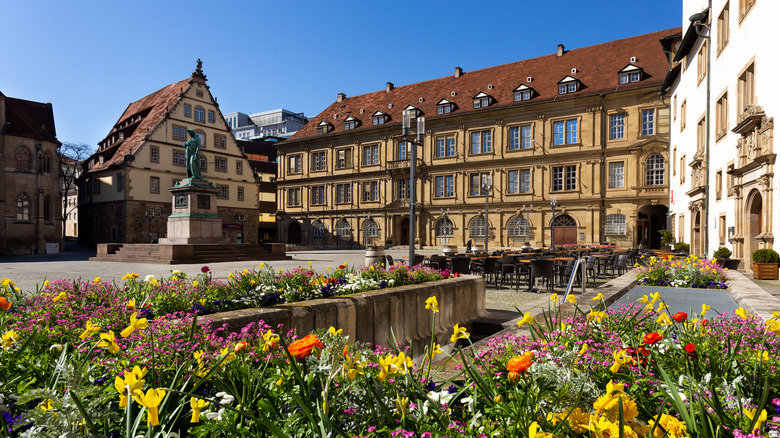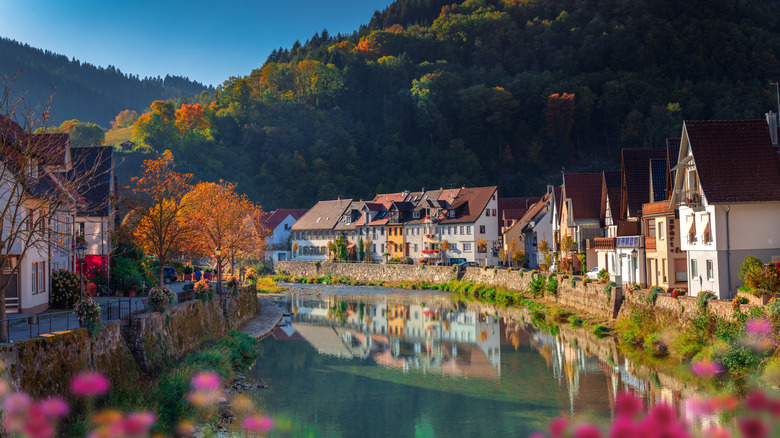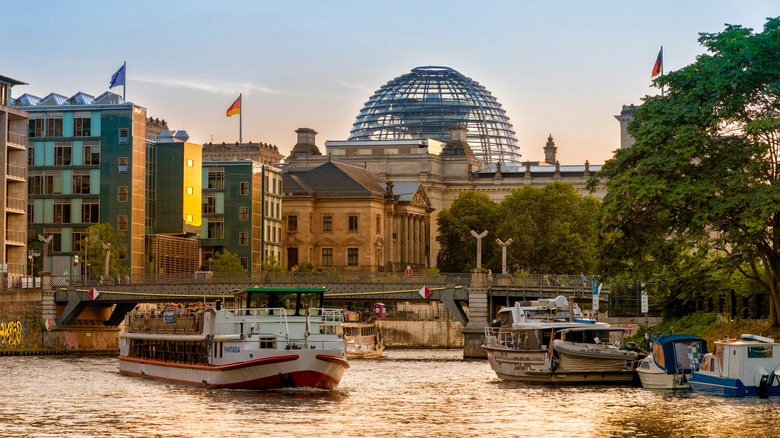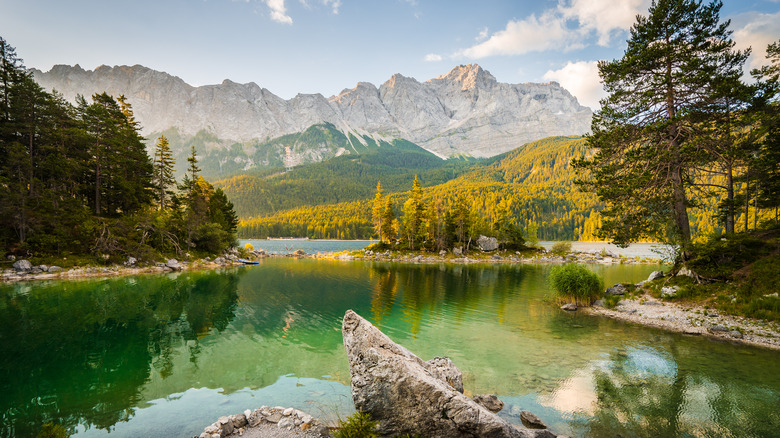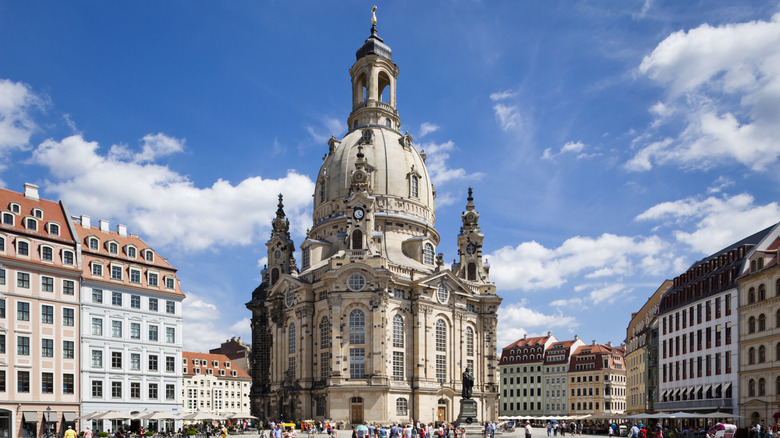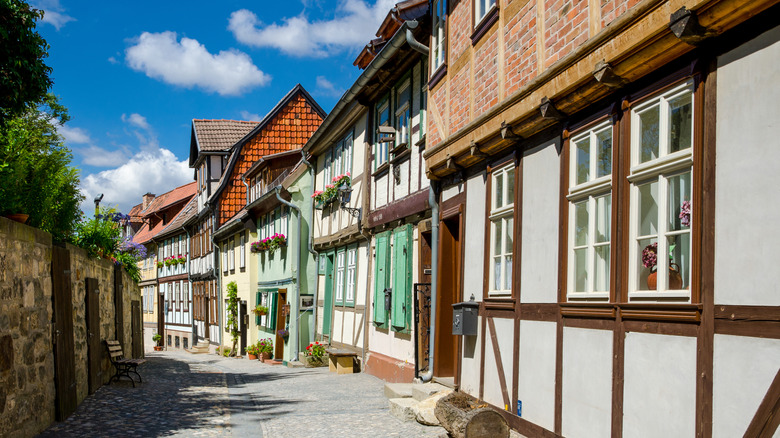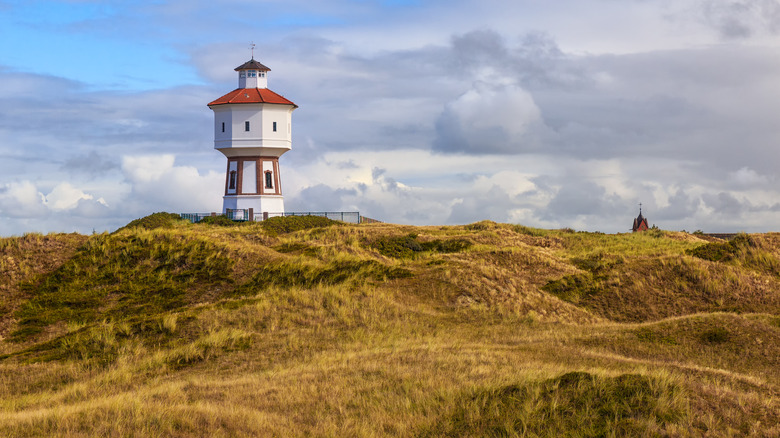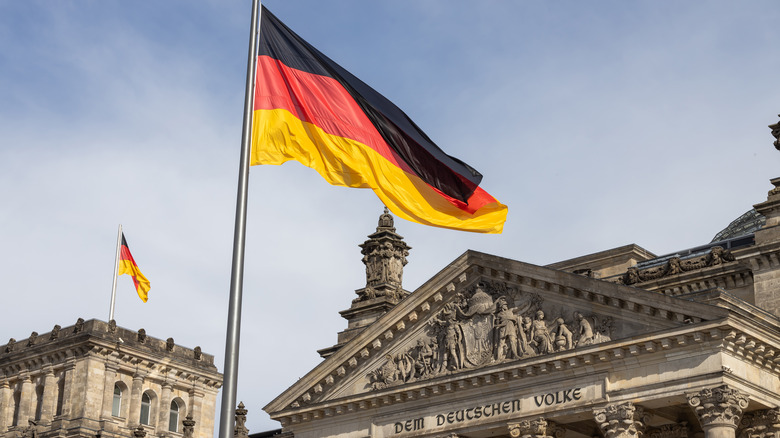The Best Destinations You Can't Skip On A Trip To Germany, According To Locals
A country roughly the size of Montana, Germany is known for its castles, lakes, cathedrals, and beer. Spend some time there, however, and you'll find that there is a lot more to Germany than most people realize. There are fantastic vineyards, car-free islands, and spas that will make you feel like royalty. The country's many regional cuisines feature exquisite meats, vegetables, fruits, and dairy products that will keep you coming back for more. And have we mentioned the art scene, resplendent with historic and modern works alike?
We asked two locals, one based in Stuttgart and one based in Cologne, for the destinations they most recommend on a trip to Germany. Their answers are summarized in this list that doubles as a highlight reel of the gorgeous, informative, and inspiring activities that one can pursue across the country. Of course, it would be difficult to capture Germany's full glory in a single trip, but you can certainly hit a few of these locations on one vacation. Take advantage of the country's wonderful train system or rent a car to get from place to place. Just make sure to pack your tennis shoes, as you are in for an active vacation no matter where you go!
Sankt Goar
If sipping on wine and stepping back in time as you explore historic castles and fortresses sounds like your kind of holiday, then head to Sankt Goar. This river town is located in the Upper Middle Rhine Valley, a region that was recognized as a UNESCO World Heritage Site in 2002 due to its immense mythical repertoire and rich history of human-ecological interaction. You'll marvel at how the architectural ruins in and around St. Goar seem as natural to the landscape as the trees themselves. The best time of year to visit Sankt Goar is from June until September when the weather is warm and the sky is painted a vibrant shade of blue.
Not to be missed on your visit to Sankt Goar is a stop by Rheinfels Castle, which is considered to be one of the most magnificent castles in the area. It houses a museum that helps contextualize the castle's features and history, making it worthwhile to pop in here before visiting any of the other castles on your list. For a funkier excursion, head to the Deutsches Puppen- und Bärenmuseum (the German Dolls and Bears Museum), where more than 3,000 dolls, 700 bears, and 35 dollhouses are on display.
Of course, if you are a lover of Riesling, you must take a tour of the local wineries (other wine varieties are also produced in the valley). Alternatively, browse the wine and brandy selection at Stefan's Wine Paradise, where you can enjoy free samples and the famous kindness of Stefan himself.
Cologne
Located in western Germany just south of Düsseldorf, Cologne is a city brimming with museums, churches, and hearty food. Cologne is a popular city to visit if you want to join in the revelries of Carnival, a festival that takes place just before Lent each year. In fact, Cologne is great for visiting year-round, and we ranked it as one of the European destinations that are best to visit in December. Even when the weather is cold and dreary, you can step inside one of the city's famous beer halls or the mouthwatering chocolate museum. The Christmas markets are magical and abundant, and each one has its own unique charm. For a luxurious reprieve, visit the famous bathhouse known as Neptunbad, where you can make use of the venue's fitness facilities as well as savor massages, gourmet food, and saunas.
One of Cologne's most magnificent landmarks is the Kölner Dom, a cathedral that was built over the course of over 600 years, between 1248 and 1880. Gothic in design, the cathedral was classified as a UNESCO World Heritage Site in 1996. It is revered for its complicated, exquisite architectural features that demonstrate a culture of devout faith; even the portions that were constructed most recently remain medieval in style. Step inside for a chance to glimpse many famous pieces of art, including the 12th and 13th century Shrine of the Magi and the 10th century Gero Crucifix.
Lake of Constance
The German, Swiss, and Austrian cultures share a generous handful of similarities, and a visit to Lake of Constance (otherwise known as "Bodensee" in Germany) will allow you to visit all three countries in a day's trip if that's what your heart desires. The lake's northern border falls entirely under the German domain, and the 110 miles of German shoreline is packed with activities to keep you occupied for days.
Year-round, you'll be able to see snow on the mountain peaks surrounding Lake Constance. This lends a unique perspective to a day of paddling on the lake during the summer and forms an open invitation to soak in the area's thermal baths during the winter. The lake is a fantastic destination to visit any time of the year; even when the weather is not ideal, you can visit attractions such as Meersburg Castle, which is Germany's oldest inhabited castle, and the Uhldingen Reptile House, not to mention a number of local wineries. Friedrichshafen is one of the larger communities along the lake's shore, known for its Zeppelin hangar and museum that inspires innovation with more than 1,500 exhibits.
During warmer months, you might like to pitch a tent in one of the area's numerous campgrounds. Otherwise, plenty of bed and breakfasts are ready to welcome you with warm beds and local foods like apples, plums, asparagus, whitefish, and cheese fondue. Dünnele, or flatbreads adorned with ingredients ranging from smoked salmon to plums, are not to be missed.
Stuttgart
Stuttgart is a small city, but one that will charm you with its abundance of art, museums, and cultural experiences. It is a city worth visiting no matter the time of the year, and there always seems to be a festival going on. The capital of Baden-Württemberg, one of Germany's southwestern states, Stuttgart combines natural features with manmade attractions to a degree that is unrivaled by most other cities.
If museums tend to bore you, think again: Stuttgart's collections are truly engaging and entertaining. For instance, the Mercedes-Benz Museum features over 160 vehicles of interest, some demonstrating the early days of automobile design and others showcasing what might still come in the future. Meanwhile, the Porsche Museum is located in a sleek, modern building that will make your jaw drop as much as the fancy cars contained within.
If you'd rather spend your time outside, there are plenty of opportunities to do so in Stuttgart. The Wilhelma is Germany's sole zoological-botanical garden, and you'll come away from the 19th-century grounds with a richer knowledge about flora and fauna from all around the world. Alternatively, the Killesberg Heights Park is a vast natural area replete with a playground, meadows full of flowers and wildlife, and the Killesberg Tower, which gives those who are willing to climb its 174 steps a magnificent view of the surrounding forests. If you are visiting the city during the holiday season, Stuttgart's Christmas market is quaint, and while it may be smaller than the markets found in larger cities, it nevertheless offers staples like Glühwein and artisan crafts.
Schwarzwald
If the Brothers Grimm's fairy tales were an integral part of your childhood, then you'll love a visit to Germany's Schwarzwald, otherwise known as the Black Forest. This mountain range is tucked away in Germany's southwest corner, near where the country borders France and Switzerland, and its mystical forests are famous for inspiring many of the fairy tales that now fill children's books and light up the silver screen, including "Sleeping Beauty" and "Hansel and Gretel." While we're willing to bet that you won't run into any evil witches or slumbering princesses during your stay in Schwarzwald, you will get a chance to see such wonders as the world's biggest cuckoo clock and the country's highest waterfall, both located in Triberg.
You can expect a comfortable, yet informative stay in this cultural gem of Germany. Indeed, tradition and modernity can be found side by side in Schwarzwald. For instance, Freiburg is a medieval artsy college town with a sunny disposition that is full of historic canals and art museums, but also sustainability initiatives and bike paths.
Schwarzwald is enchanting during the winter when snow coats tree limbs and blankets the ground, but also equally enjoyable during warmer months, when you can take to miles and miles of hiking trails. Rail routes such as the Black Forest Railway make it easier to explore a greater breadth of the region. Make sure to sample the local cuisine during your stay in Schwarzwald, including a slice (or two) of Black Forest cake, Käsespätzle, and Weisswurst.
Berlin
Berlin is among the handful of German cities that typically attract first-time visitors, and for good reason: It is progressive, yet historic, easy to access, and replete with activities to engage people of all ages no matter the time of year. For example, while you might spend the morning touring the art collections of the Humboldt Forum, you could follow it up with a visit to an indoor waterpark that feels like an exotic getaway. There are many free activities in the city, too. The famous Reichstag Building, which is easily identifiable by its Neoclassical architecture and Norman Foster-designed glass dome, is a paradise for those who like to pour over history books. The building stands as a symbol of many eras, including Hitler's rise to power and the beginning of the Cold War. While touring the dome is free, be sure to reserve your entry in advance.
A number of walking tours are available that will take you through the various neighborhoods of Berlin. Guided by experts, you can book one of these tours to learn about topics like the Cold War, the Berlin Wall, feminist icons, street art, and Germany's culinary scene. Even if you don't take a food tour, be sure to take advantage of Berlin's diversity of restaurants, where you can sample German delicacies like Flammkuchen, kebab, and, of course, beer. Dozens of craft breweries, beach bars, and beer gardens dot the city, each of which can introduce visitors to their new favorite brew.
Eibsee
Eibsee is celebrated as one of the most picturesque lakes in Germany. The product of a landslide that occurred over 3,000 years ago, it is today a paradise for active, outdoorsy folks, as well as those who simply love to soak up stunning scenery. Eibsee is a premier destination for swimming, paddling, boating, and hiking during the warmest months of the year, but it also boasts excellent winter activities, such as the Zugspitz Spa Grainau. This spa features various pools, saunas, and even an infrared cabin, and children and toddlers can also splash around in pools dedicated to their enjoyment. Another highlight of Grainau is the Höllental Gorge. Open from May until October, you can hike to the dramatic gorge on a trail that requires 60 to 90 minutes of your time, all the while marveling at how the bridges, tunnels, and footpaths compliment the stark alpine landscape.
Conveniently, Eibsee is located adjacent to another famous natural attraction: Zugspitze, the highest mountain in Germany. Ascending the 2,962-meter Zugspitze in a cable car is a memorable experience for people of all ages, and if the upward journey gets your mental gears turning, stop by the "90 Years of the Cogwheel Train" exhibition. Here, you'll learn more about the history of cogwheel trains and how engineers have overcome hurdles like weather and challenging terrain to build such monumental pieces of transportation infrastructure. Those who are looking for a more active adventure can ski, snowboard, and toboggan on the mountain; go mountaineering; or hike to the highest church in Germany. When you are ready to refuel from the day's adventures, take a seat in one of the summit's restaurants to indulge in classic Bavarian food.
Dresden
You may remember Dresden from your history books as one of Germany's most bombed cities during World War II. It only makes sense, then, that this is a great destination for history buffs looking to brush up on their knowledge of the war by touring museums and infamous bombing sites. For instance, the stunning Frauenkirche was brought to rubble during World War II but was reconstructed at the turn of the 21st century thanks to generous foreign donations.
However, there is plenty more to Dresden than its martial past. The city also boasts several palaces, a nearby national park, and a river that provides a lovely backdrop for romantic cruises. You might spend a day at the historic Pillnitz Palace and Park, a family-friendly three-palace park that is a treat for the eyes and nose. Alternatively, you can shop, dine, and visit art galleries in Dresden's Neustadt or view the city from the Elbe River while aboard a steamboat.
Dresden is only about 45 minutes from Saxon Switzerland National Park, one of Germany's prettiest national parks that is an underrated gem with unique landscapes. This trip into the German countryside is especially worthwhile for those who love nothing more than to lace up their hiking boots; peculiar rock formations, cliffs, and valleys will delight visitors along nearly 750 miles of trail. The park is also home to the Malerweg Trail, which some say is the most beloved hiking route in the country.
Quedlinburg
If medieval streets mesmerize you and castles tend to call your name, you must include Quedlinburg in your vacation itinerary. This town is just north of the Harz Mountains and is also Germany's first capital. In fact, this UNESCO World Heritage City is over 1,000 years old, and to prove it, you can find 2,000 houses constructed in the historic half-timbered architectural style, hailing from eight different centuries. The town's layout is indicative of traditional Middle Age city planning, and the castle hill features a number of important buildings, including the Collegiate Church of St. Servatii. Plan a leisurely few hours here so that you can stroll through the gardens, wonder at the views, and soak up the history.
The countryside surrounding Quedlinburg is equally stunning. Not far from the city is Teufelsmauer, which translates to "the devil's wall." You'll begin to understand why this nature reserve has earned such an ominous name once you see the odd sandstone rock formation for which the reserve is known. For the most fulfilling experience, take the time to learn a few of the legends surrounding the stones before visiting.
The Selke Valley Trail provides another opportunity to explore the Harz Mountains on foot. With one end in Quedlinburg's Old Town, this 43-mile trail allows you to witness peaceful ponds or dramatic mountain landscapes, depending on where you access it. It also takes hikers by several intriguing castles.
Langeoog
Germans love the calming, car-free atmosphere of Langeoog, a small island of only about eight square miles that nevertheless features nearly nine miles of beaches, plenty of grandiose sand dunes, and mudflats that house a wide array of wildlife. The island is located in the North Sea, and you can access it by ferry. Upon arrival, you'll immediately notice the lack of noise pollution and how fresh the air is. You can then take a seven-minute ride aboard the Langeoog Island train to reach the main area of town. Visitors must then roam the island on their own two feet, by bike, on horseback, or in a horse-drawn carriage.
Relish your retreat away from modern civilization by setting out on a hike along one of the island's two main trails: Osterhook and Flinthörn. Keep in mind that whenever you hike on the beach, going at low tide is best so that you can comfortably walk on wet sand as opposed to soft, pillowy sand. If it's warm, chase waves with a surfboard and pack your suit for a swim. Ascending the island's water tower is exciting for kids and adults alike, and you can tour it between April and October. If marine wildlife fascinates you, take a trip to the island's aquarium, or, even better, visit the Lower Saxony Wadden Sea National Park to learn about salt marshes, bogs, sand dunes, and wildlife like seals and shelducks. In the mood for a substantial dose of relaxation? No matter the weather, you can always enjoy a treatment at one of the island's highly acclaimed spas.
Methodology
In determining the locations for this list, we mainly drew upon the expertise of two German citizens: One who lives in Cologne and one who lives in Stuttgart. We augmented their suggestions with our own personal experiences to craft a guide that showcases the incredible diversity of Germany's people, subcultures, and landscapes. From the southern region of Bavaria to the country's northernmost islands, Germany has a lot in store for first-time visitors, no matter what their interests are.
